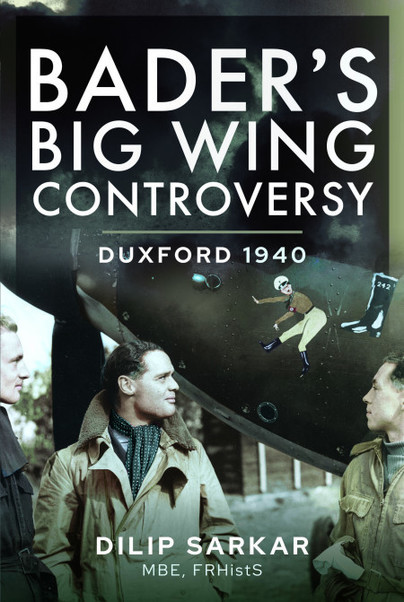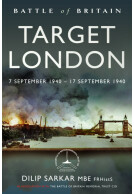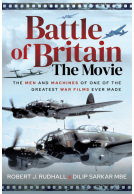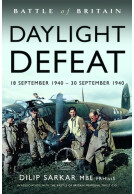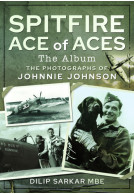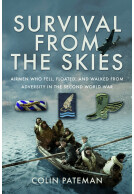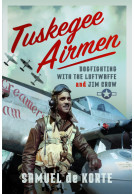Bader’s Big Wing Controversy (Hardback)
Duxford 1940
Imprint: Air World
Pages: 272
ISBN: 9781399017152
Published: 17th November 2021
(click here for international delivery rates)
Need a currency converter? Check XE.com for live rates
| Other formats available - Buy the Hardback and get the eBook for £1.99! | Price |
|---|---|
| Bader’s Big Wing Controversy ePub (6.6 MB) Add to Basket | £6.99 |
Group Captain Sir Douglas Bader remains one of the most famous RAF fighter pilots to date, perhaps even the most famous of all, thanks to Paul Brickhill’s best-selling 1950s yarn Reach for the Sky and Dany Angel’s box office hit of the same name, starring Kenneth Moore.
Bader, a graduate of the RAF College Cranwell and a professional, career officer, was a gifted sportsman and aerobatic pilot – but headstrong. After a crash that led to the amputation of both of his legs, the Second World War was this man of action’s salvation: passing a flying test, he returned to the RAF, first flying Spitfires with 19 Squadron at Duxford. In due course he was posted to 222 Squadron as a flight commander, seeing action over Dunkirk.
Already newsworthy, the swashbuckling, legless, fighter pilot was also a favourite of his Station Commander, Wing Commander A.B. ‘Woody’ Woodhall, and, more importantly, his 12 Group Air Officer Commanding, Air Vice-Marshal Leigh-Mallory. In short order, therefore, Bader was soon elevated to Acting Squadron Leader and given command of 242 Squadron, a Canadian Hurricane squadron which he led throughout the Battle of Britain.
On 30 August 1940, 12 Group was requested to reinforce 11 Group and intercept a raid on an aircraft factory at Hatfield. This was Bader and 242 Squadron’s first experience of a mass German raid, and many combat claims were subsequently filed. The events that day led Bader to submit a report arguing that the more fighters he had at his disposal, the greater would be the execution of the enemy that could be achieved. It was a concept that received support from Leigh-Mallory, who recognised an opportunity for 12 Group to play a greater part in what was clearly an historic battle. Leigh-Mallory authorised Bader to lead three, then five, squadrons – a controversial formation that came to be known as the ‘Duxford Wing’ or ‘Big Wing’.
In Bader’s Big Wing Controversy, Dilip Sarkar not only explores the full story of the people and events that led to the creation of the ‘Big Wing’ at Duxford, he also fully investigates the part that its men and machines played in the Battle of Britain story. Whilst Bader was not personally intending disloyalty, as such, to his Air Officer Commander-in-Chief, Air Chief Marshal Sir Hugh Dowding, he was, as the latter once commented, ‘the cause of a lot of the trouble’. In his burning desire to propel 242 Squadron and himself, its leader, into the forefront of the action, the newsworthy acting squadron leader found himself used by darker forces, men with axes to grind and personal ambitions to further.
I have now finished reading your most excellent Bader's Big Wing Controversy. It's been a reminder to me of just how long it can take after significant events for truly authoritative analysis to occur. You, as an historian will understand this more than most. I guess that close proximity to great events, is too close to see the wood for the trees. Besides which, victors of any conflict tend to lay claim to the immediate narrative. However, distance in time perhaps allows for more objective, considered review, including of antagonists' prespectives.
Stephen Park, great-nephew of Air Chief Marshal Sir Keith Park
Amongst other things, I was unaware of the critical impact of the limitations of radio technology of the time on basic squadron strategy during the BoB. You make the point yourself that that is too often overlooked by others. Such an obvious technical constraint. I could go on ...
Anyway, a terrific read. My pile of other reading was shunted aside for the duration, and will have to wait a bit longer because I've just started on The Gathering Storm!
Dilip has carefully collected all the facts and pieced together what really happened, then worked out and explained better than anyone else "why".
Aeromodeller December 2022
I found the book fascinating and thoroughly commend it to you all.
As Featured In
Scramble 1940, Spring/Summer 2022
"An excellent work for both the general and specialist reader of the history of air warfare."
Martin Willoughby, The Wessex Branch of the Western Front Association
Reach for the Sky with Kenneth More remains one of my favouite British films of all time - and Dilip Sarkar's latest WW2 book will almost certainly become a favourite read - remarkable and hugely enjoyable.
Books Monthly
The book is diligently researched and written well. It is logically laid out and very easy to follow the argument from both sides.
ARRSE (Army Rumour Service)
Overall a good book and one that deserves 4.5 Mr Mushroom Heads.
Read the full review here
Rating: 5 out of 5 stars
NetGalley, Kevin Manley
The author is to be congratulated for giving readers a book that covers and adds significantly to a subject that has already been the focus of many other histories of those fateful months in 1940 and the disgraceful treatment of the two senior RAF leaders who did more to ensure that we can look back on the Battle of Britain as a deliverance. Dilip Sarkar provides a mass of detailed information to set out a clear analysis that explains how and why the Head of the Royal Air Force Fighter Command, Hugh Dowding and Keith Park, the Air Officer Commanding number 11 Group, that saw the most intensive air to air combat of the Battle of Britain, were unceremoniously removed from their commands soon after the day we now celebrate as Battle of Britain Day. The ‘Big Wing’ controversy is a topic most readers looking to this book will be familiar with. However, the shocking treatment of Dowding and Park by the ‘inner circle’ within the Air Ministry and the clique of senior officers and junior officers from their Cranwell days is shameful and little excused by reference to ‘different times’.
Strongly recommended
Rating: 5 out of 5 stars
NetGalley, Dawn Lewis
My dad introduced me to Douglas Bader through the film "Reach for the Sky" when I was very young (it was also the last film I ever watched with him), and I've never lost my admiration. Really, anyone who has watched the film should read this book as it gives a far more rounded picture of who Bader was and the events surrounding him. I'm sure my dad would have loved this book too - and he would have thoroughly enjoyed the photos, as I did. Brilliantly written, informative, and a darn good read!
The way this book was written allowed the book to flow so easily. I particular like the air battle scenes, getting a timeline of the events and then a round up at the end summarizing the losses and damages of the battles. I also found that even though this book was written about a controversy, I never got the sense that the author was one on side, the writing felt very neutral. It was also good seeing some opinions on the Big Wing at the end and getting contrasting views.
NetGalley, Becky Cornell-Webb
Dilip managed to make Bader's personality really shine through in this book and you could clearly see why so many people were willing to follow him wherever he goes and how unfortunately some took advantage of this. You come out of this book feeling proud that the men fighting in our skies were on our side during the Battle of Britain and more educated on matters that you weren't aware happened during WW2.
As Dilip Sarkar says in his introduction, Douglas Bader became a household name and probably the most famous RAF pilot of WW2 through the Paul Brickhill biography Reach for the Sky, later made into a film with Kenneth More playing the lead role. Their portrayal of a determined, competitive individual who sought to excel at everything he ventured combined with an engaging personality and boundless enthusiasm is truly what heroes are made from. That is what makes this book a fascinating challenge for Sarkar, to piece together a compelling argument that Bader’s most notable contribution to the Battle of Britain (the concept of attack through multi squadron “big wings”) was not as successful as was claimed at the time. This he achieves with great skill compiling a forensic level of detail citing Air Ministry and Luftwaffe records, primary source documents and recorded interviews with some of the main actors. It becomes a compelling story covering, in detail, the plan of Air Chief Marshal Sir Hugh Dowding to defend the UK under attack from German bombers and Fighters in 1940. There is plenty of detail for the true WW2 fans on how this defense plan worked in action on a day-to-day basis. However, the real intrigue in the book is the background clash of personalities in the RAF Leadership eventually leading to a shameful outcome where the true heroes responsible for victory in the Battle of Britain are banished to the sidelines as others bask in the glory.
NetGalley, Michael Neill
About Dilip Sarkar MBE FRHistS FRAeS
Dilip Sarkar has now written over sixty well-received books. Having enjoyed a privileged relationship with many of The Few, he is a globally acknowledged expert on the Battle of Britain, currently working on a career-topping eight volume official history for The Battle of Britain Memorial Trust and National Memorial to The Few. Described by the late Dr Gordon Mitchell, son of the Spitfire’s designer RJ Mitchell, as an ‘aviation detective’, Dilip Sarkar did actually begin his professional life as just that – a police detective. His evidence-based approach and ability to discover new material is well-known – in 2023, for example, he was responsible for having Air Chief-Marshal Sir Keith Park, a New Zealander, officially recognised as one of The Few. Made an MBE for ‘services to aviation history’ in 2003, Dilip was elected to the Fellowship of the Royal Historical Society in 2006, achieved First Class Honours in Modern History as a mature student in 2010, and in 2024 was made both a Fellow of the Royal Aeronautical Society and member of London’s Royal Air Force Club. During his long career, Dilip has exhibited and spoken internationally at such prestigious venues as Oxford University, the RAF Museum, IWM Museum, and Airborne Museum, Oosterbeek; he has worked on many TV documentaries, on and off screen, again internationally, and has an engaging presence on YouTube and Facebook in particular.
Bader’s Spitfire Wing Tangmere 1941 (Hardback)
On 30 August 1940, at the height of the Battle of Britain, the pilots of RAF Fighter Command’s No.12 Group were requested to reinforce 11 Group and intercept a Luftwaffe raid on an aircraft factory at Hatfield. The events that day led the swashbuckling, legless, fighter pilot Douglas Bader to submit a report arguing that the more fighters he had at his disposal, the greater would be the execution of the enemy that could be achieved. It was a concept that received support from 12 Group’s Air Officer Commanding, Air Vice-Marshal Leigh-Mallory. In Bader’s proposal, Leigh-Mallory saw an opportunity…
By Dilip Sarkar MBE FRHistS FRAeSClick here to buy both titles for £43.00







